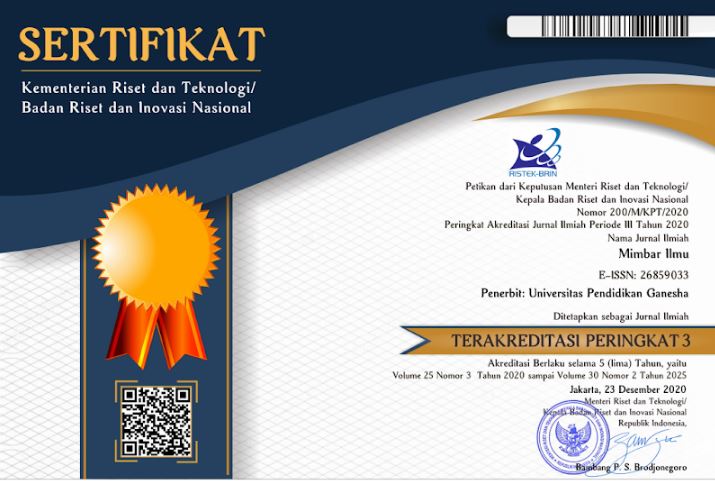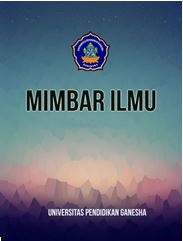Primary Students’ Math Literacy in terms of Higher Order Thinking Skill
DOI:
https://doi.org/10.23887/mi.v27i2.48435Kata Kunci:
HOTS, Primary School, Math LiteracyAbstrak
Primary students' math literacy is still inadequate. This is due to the limited number of problems based on math literacy, while studies analyzing math literacy require high-order thinking skills (HOTS). This study aims to develop instruments and analyze primary students' math literacy by reviewing high order thinking (HOTS). The study participants were 30 fifth-grade primary school students by grouping students into three HOTS levels: low, medium, and high. The study method uses a mixed-method (quantitative and qualitative) with an explanatory sequential design. The research instrument is an initial math literacy test (ML-T) that focuses on content, context, process, and level. Data analysis used descriptive statistics. The results of the study resulted in 15 ML-T which had been declared valid and reliable, divided into 6 items at levels 1-2 (easy), 5 items at levels 3-4 (enough), and 4 items at levels 5-6 (hard). The results of another study show that the success of primary students' math literacy depends on the level of ML-T problems and students' HOTS abilities. Higher ML-T levels tend to be completed with math literacy in the perspective of higher HOTS levels of students. This study's implication is to contribute to developing authentic math literacy instruments and analyzing the success of primary students' math literacy by looking at the HOTS level.
Referensi
Abadi, M. A. S., & Amir, M. F. (2022). Analysis of the elementary school students difficulties of in solving perimeter and area problems. JIPM (Jurnal Ilmiah Pendidikan Matematika), 10(2), 396–408. https://doi.org/10.25273/jipm.v10i2.11053. DOI: https://doi.org/10.25273/jipm.v10i2.11053
Abidin, Z., Utomo, A. C., Pratiwi, V., & Farokhah, L. (2020). Project-based learning-literacy in improving students’ mathematical reasoning abilities in elementary schools. JMIE (Journal of Madrasah Ibtidaiyah Education), 4(1), 39. https://doi.org/10.32934/jmie.v4i1.170. DOI: https://doi.org/10.32934/jmie.v4i1.170
Amir, F., & Amir, M. F. (2021). Action proof: Analyzing elementary school students informal proving stages through counter-examples. International Journal of Elementary Education, 5(2), 401–408. https://doi.org/10.23887/ijee.v5i3.35089. DOI: https://doi.org/10.23887/ijee.v5i3.35089
Amir, M. F., Mufarikhah, I. A., Wahyuni, A., Nasrun, & Rudyanto, H. E. (2019). Developing ‘fort defending’ game as a learning design for mathematical literacy integrated to primary school curriculum in indonesia. Elementary Education Online, 18(3). https://doi.org/10.17051/ilkonline.2019.610145. DOI: https://doi.org/10.17051/ilkonline.2019.610145
Antara, I. G. W. S., & Dewantara, K. A. K. (2022). E-Scrapbook: The Needs of HOTS Oriented Digital Learning Media in Elementary Schools. Journal for Lesson and Learning Studies, 5(1), 71–76. https://doi.org/10.23887/jlls.v5i1.48533. DOI: https://doi.org/10.23887/jlls.v5i1.48533
Armstrong, A., Ming, K., & Helf, S. (2018). Content area literacy in the mathematics classroom. The Clearing House: A Journal of Educational Strategies, Issues and Ideas, 91(2), 85–95. https://doi.org/10.1080/00098655.2017.1411131. DOI: https://doi.org/10.1080/00098655.2017.1411131
Balashov, E., Pasicichnyk, I., & Kalamazh, R. (2021). Metacognitive awareness and academic self-regulation of hei students. International Journal of Cognitive Research in Science, Engineering and Education, 9(2), 161–172. https://doi.org/10.23947/2334-8496-2021-9-2-161-172. DOI: https://doi.org/10.23947/2334-8496-2021-9-2-161-172
Brezovszky, B., McMullen, J., Veermans, K., Hannula-Sormunen, M. M., Rodríguez-Aflecht, G., Pongsakdi, N., Laakkonen, E., & Lehtinen, E. (2019). Effects of a mathematics game-based learning environment on primary school students’ adaptive number knowledge. Computers and Education, 128(August 2018), 63–74. https://doi.org/10.1016/j.compedu.2018.09.011. DOI: https://doi.org/10.1016/j.compedu.2018.09.011
Brown, R. (2017). Using collective argumentation to engage students in a primary mathematics classroom. Mathematics Education Research Journal, 29(2), 183–199. https://doi.org/10.1007/s13394-017-0198-2. DOI: https://doi.org/10.1007/s13394-017-0198-2
Campbell, L., Gray, S., Macintyre, T., & Stone, K. (2020). Literacy, numeracy and health and wellbeing across learning: Investigating student teachers’ confidence. International Journal of Educational Research, 100(April 2019), 1–12. https://doi.org/10.1016/j.ijer.2020.101532. DOI: https://doi.org/10.1016/j.ijer.2020.101532
Chu, J., Rittle-Johnson, B., & Fyfe, E. R. (2017). Diagrams benefit symbolic problem-solving. British Journal of Educational Psychology, 87(2), 273–287. https://doi.org/10.1111/bjep.12149. DOI: https://doi.org/10.1111/bjep.12149
Clarke, D., & Roche, A. (2018). Using contextualized tasks to engage students in meaningful and worthwhile mathematics learning. Journal of Mathematical Behavior, 51(September), 95–108. https://doi.org/10.1016/j.jmathb.2017.11.006. DOI: https://doi.org/10.1016/j.jmathb.2017.11.006
Colwell, J., & Enderson, M. C. (2016). When I hear literacy: Using pre-service teachers’ perceptions of mathematical literacy to inform program changes in teacher education. Teaching and Teacher Education, 53, 63–74. https://doi.org/10.1016/j.tate.2015.11.001. DOI: https://doi.org/10.1016/j.tate.2015.11.001
Creswell, J. W., & Guetterman, T. C. (2018). Educational Research: planning, conducting, and evaluating quantitative and qualitative research, 6th Edition. Pearson Education.
Duran, M., & Bekdem, M. (2013). Evaluation of visual math literacy self efficacy perception with visual mathematics accomplishment. Pegem Journal of Education and Instruction, 3(3), 27–40. https://doi.org/10.14527/C3S3M3. DOI: https://doi.org/10.14527/C3S3M3
Ekawati, R., Susanti, S., & Chen, J.-C. (2020). Primary students’ mathematical literacy: A case study. Infinity Journal, 9(1), 49–58. https://doi.org/10.22460/infinity.v9i1.p49-58. DOI: https://doi.org/10.22460/infinity.v9i1.p49-58
Fadillah, A., & Ni’mah. (2019). Analisis literasi matematika siswa dalam memecahkan soal matematika PISA konten change and relationship. JTAM (Jurnal Teori Dan Aplikasi Matematika), 3(2), 127–131. https://doi.org/10.31764/jtam.v3i2.1035. DOI: https://doi.org/10.31764/jtam.v3i1.752
Firdaus, M. F., Wahyudin, & Herman, T. (2017). Improving primary students mathematical literacy through problem based learning and direct instruction. Educational Research and Reviews, 12(4), 212–219. https://doi.org/10.5897/err2016.3072. DOI: https://doi.org/10.5897/ERR2016.3072
Genc, M., & Erbas, A. K. (2019). Secondary mathematics teachers‘ conceptions of mathematical literacy. International Journal of Education in Mathematics, Science and Technology, 7(3), 222–237. https://ijemst.org/index.php/ijemst/article/view/611.
Gravemeijer, K., Stephan, M., Julie, C., Lin, F. L., & Ohtani, M. (2017). What mathematics education may prepare students for the society of the future? International Journal of Science and Mathematics Education, 15, 105–123. https://doi.org/10.1007/s10763-017-9814-6. DOI: https://doi.org/10.1007/s10763-017-9814-6
Güner, P., & Erbay, H. N. (2021). Prospective mathematics teachers’ thinking styles and problem-solving skills. Thinking Skills and Creativity, 40(April), 100827. https://doi.org/10.1016/j.tsc.2021.100827. DOI: https://doi.org/10.1016/j.tsc.2021.100827
Herrmann, S., Meissner, C., Nussbaumer, M., & Ditton, H. (2022). Matthew or compensatory effects? Factors that influence the math literacy of primary-school children in Germany. British Journal of Educational Psychology, 92(2), 518–534. https://doi.org/10.1111/bjep.12462. DOI: https://doi.org/10.1111/bjep.12462
Kaskens, J., Segers, E., Goei, S. L., van Luit, J. E. H., & Verhoeven, L. (2020). Impact of children’s math self-concept, math self-efficacy, math anxiety, and teacher competencies on math development. Teaching and Teacher Education, 94, 103096. https://doi.org/10.1016/j.tate.2020.103096. DOI: https://doi.org/10.1016/j.tate.2020.103096
Ketonen, E. E., & Hotulainen, R. (2019). Development of low-stakes mathematics and literacy test scores during lower secondary school – A multilevel pattern-centered analysis of student and classroom differences. Contemporary Educational Psychology, 59(July), 101793. https://doi.org/10.1016/j.cedpsych.2019.101793. DOI: https://doi.org/10.1016/j.cedpsych.2019.101793
Khaldi, K. (2017). Quantitative, qualitative or mixed research: which research paradigm to use? Journal of Educational and Social Research, 7(2), 15–15. https://doi.org/10.5901/jesr.2017.v7n2p15. DOI: https://doi.org/10.5901/jesr.2017.v7n2p15
Kim, K., & Tawfik, A. A. (2021). Different approaches to collaborative problem solving between successful versus less successful problem solvers: Tracking changes of knowledge structure. Journal of Research on Technology in Education. https://doi.org/10.1080/15391523.2021.2014374. DOI: https://doi.org/10.1080/15391523.2021.2014374
Kolar, V. M., & Hodnik, T. (2021). Mathematical literacy from the perspective of solving contextual problems. European Journal of Educational Research, 10(1), 467–483. https://doi.org/10.12973/EU-JER.10.1.467. DOI: https://doi.org/10.12973/eu-jer.10.1.467
Kurniawati, L., & Amir, M. F. (2022). Development of learning trajectory of perimeter and area of squares and rectangles through various tasks. Premiere Educandum, 12(1), 41–55. https://doi.org/10.25273/pe.v12i1.12121. DOI: https://doi.org/10.25273/pe.v12i1.12121
Lara-Porras, A. M., Rueda-García, M. D. M., & Molina-Muñoz, D. (2019). Identifying the factors influencing mathematical literacy in several Spanish regions. South African Journal of Education, 39, 1–13. https://doi.org/10.15700/saje.v39ns2a1630. DOI: https://doi.org/10.15700/saje.v39ns2a1630
Li, C. H. (2016). Confirmatory factor analysis with ordinal data: Comparing robust maximum likelihood and diagonally weighted least squares. Behavior Research Methods, 48(3), 936–949. https://doi.org/10.3758/s13428-015-0619-7. DOI: https://doi.org/10.3758/s13428-015-0619-7
Mevarech, Z. R., & Fan, L. (2018). Cognition, metacognition, and mathematics literacy. In Innovations in Science Education and Technology, vol 24 (pp. 261–278). Springer, Cham. https://doi.org/10.1007/978-3-319-66659-4_12. DOI: https://doi.org/10.1007/978-3-319-66659-4_12
Milinia, R., & Amir, M. F. (2022). The analysis of primary students’ earning obstacles on plane figures’ perimeter and area using onto-semiotic approach. Al Ibtida: Jurnal Pendidikan Guru MI, 9(1), 19–33. https://doi.org/10.24235/al.ibtida.snj.v9i1.9958. DOI: https://doi.org/10.24235/al.ibtida.snj.v9i1.9958
Murtonen, M., & Balloo, K. (2019). Redefining scientific thinking for higher education. Palgrave Macmillan Cham. https://doi.org/10.1007/978-3-030-24215-2_2. DOI: https://doi.org/10.1007/978-3-030-24215-2
Narayani, N. P. U. D. (2019). Pengaruh Pendekatan Matematika Realistik Berbasis Pemecahan Masalah Berbantuan Media Konkret Terhadap Hasil Belajar Matematika. Jurnal Ilmiah Sekolah Dasar, 3(2), 220. https://doi.org/10.23887/jisd.v3i2.17775. DOI: https://doi.org/10.23887/jisd.v3i2.17775
Nugroho, R. A. (2018). HOTS (kemampuan kerpikir tingkat tinggi: konsep, pembelajaran, penilaian, dan soal-soal). PT Gramedia Widiasarana Indonesia.
Oktiningrum, W., & Wardhani, D. A. P. (2020). Developing HOT’s mathematics task with Indonesian heritage as context to assess mathematical literacy of students in primary school. International Journal for Educational and Vocational Studies, 1(8), 69. https://doi.org/10.29103/ijevs.v2i1.1997. DOI: https://doi.org/10.29103/ijevs.v2i1.1997
Ozeno, H. (2021). Nature education : Outdoor learning of map literacy skills and reflective thinking skill towards problem-solving. Thinking Skills and Creativity, 40(December 2020), 100815. https://doi.org/10.1016/j.tsc.2021.100815. DOI: https://doi.org/10.1016/j.tsc.2021.100815
Parhiala, P., Torppa, M., Vasalampi, K., Eklund, K., Poikkeus, A. M., & Aro, T. (2018). Profiles of school motivation and emotional well-being among adolescents: Associations with math and reading performance. Learning and Individual Differences, 61(December 2017), 196–204. https://doi.org/10.1016/j.lindif.2017.12.003. DOI: https://doi.org/10.1016/j.lindif.2017.12.003
Prince, R., & Frith, V. (2020). An investigation of the relationship between academic numeracy of university students in South Africa and their mathematical and language ability. ZDM - Mathematics Education, 52(3), 433–445. https://doi.org/10.1007/s11858-019-01063-7. DOI: https://doi.org/10.1007/s11858-019-01063-7
Purpura, D. J., & Schmitt, S. A. (2019). Cross-domain development of early academic and cognitive skills. Early Childhood Research Quarterly, 46, 1–4. https://doi.org/10.1016/j.ecresq.2018.10.009. DOI: https://doi.org/10.1016/j.ecresq.2018.10.009
Rachmaningtyas, N. A., Kartowagiran, B., Sugiman, Retnawati, H., & Hassan, A. (2022). Habituation of mathematical literacy trained in junior high school. International Journal of Educational Methodology, 8(2), 321–330. https://doi.org/10.12973/ijem.8.2.321. DOI: https://doi.org/10.12973/ijem.8.2.321
Saraswati, P. M. S., & Agustika, G. N. S. (2020). Kemampuan berpikir tingkat tinggi dalam menyelesaikan soal HOTS mata pelajaran matematika. Jurnal Ilmiah Sekolah Dasar, 4(2), 257–269. https://doi.org/10.23887/jisd.v4i2.25336. DOI: https://doi.org/10.23887/jisd.v4i2.25336
Saß, S., Kampa, N., & Köller, O. (2017). The interplay of g and mathematical abilities in large-scale assessments across grades. Intelligence, 63(May), 33–44. https://doi.org/10.1016/j.intell.2017.05.001. DOI: https://doi.org/10.1016/j.intell.2017.05.001
Smith, J. M., & Mancy, R. (2018). Exploring the relationship between metacognitive and collaborative talk during group mathematical problem-solving–what do we mean by collaborative metacognition? Research in Mathematics Education, 20(1), 14–36. https://doi.org/10.1080/14794802.2017.1410215. DOI: https://doi.org/10.1080/14794802.2017.1410215
Suciati, Munadi, S., Sugiman, & Febriyanti, W. D. R. (2020). Design and validation of mathematical literacy instruments for assessment for learning in Indonesia. European Journal of Educational Research, 9(2), 865–875. https://doi.org/10.12973/eu-jer.9.2.865. DOI: https://doi.org/10.12973/eu-jer.9.2.865
Sumirattana, S., Makanong, A., & Thipkong, S. (2017). Using realistic mathematics education and the DAPIC problem-solving process to enhance secondary school students’ mathematical literacy. Kasetsart Journal of Social Sciences, 38(3), 307–315. https://doi.org/10.1016/j.kjss.2016.06.001. DOI: https://doi.org/10.1016/j.kjss.2016.06.001
Taherdoost, H. (2016). Validity and Reliability of the Research Instrument ; How to Test the Validation of a Questionnaire / Survey in a Research Hamed Taherdoost To cite this version : HAL Id : hal-02546799 Validity and Reliability of the Research Instrument ; How to Test the. International Journal of Academic Research in Management, 5(3), 28–36. https://doi.org/10.2139/ssrn.3205040. DOI: https://doi.org/10.2139/ssrn.3205040
Umbara, U., & Suryadi, D. (2019). Re-Interpretation of Mathematical Literacy Based on The Teacher’s Perspective. International Journal of Instruction, 12(4), 789–806. https://doi.org/10.29333/iji.2019.12450a. DOI: https://doi.org/10.29333/iji.2019.12450a
Uscianowski, C., Victoria, M., & Ginsburg, H. P. (2018). Differences in the complexity of math and literacy questions parents pose during storybook reading. Early Childhood Research Quarterly. https://doi.org/10.1016/j.ecresq.2018.07.003. DOI: https://doi.org/10.1016/j.ecresq.2018.07.003
Vasalampi, K., Pakarinen, E., Torppa, M., Viljaranta, J., Lerkkanen, M. K., & Poikkeus, A. M. (2020). Classroom effect on primary school students’ self-concept in literacy and mathematics. European Journal of Psychology of Education, 35(3), 625–646. https://doi.org/10.1007/s10212-019-00439-3. DOI: https://doi.org/10.1007/s10212-019-00439-3
Wang, L. (2021). The analysis of mathematics academic burden for primary school students based on PISA data analysis. Frontiers in Psychology, 12(February), 1–9. https://doi.org/10.3389/fpsyg.2021.600348. DOI: https://doi.org/10.3389/fpsyg.2021.600348
Wardono, Mariani, S., Rahayuningsih, R. T., & Winarti, E. R. (2018). Mathematical literacy ability of 9th grade students according to learning styles in problem based learning-realistic approach with Edmodo. Unnes Journal of Mathematics Education, 7(1), 48–56. https://doi.org/10.15294/ujme.v7i1.22572.
Wilkinson, L. C. (2018). Teaching the language of mathematics: What the research tells us teachers need to know and do. Journal of Mathematical Behavior, 51(April), 167–174. https://doi.org/10.1016/j.jmathb.2018.05.001. DOI: https://doi.org/10.1016/j.jmathb.2018.05.001
Zainiyah, U., & Marsigit. (2019). Improving mathematical literacy of problem solving at the 5th grade of primary students. Journal of Education and Learning (EduLearn), 13(1), 98–103. https://doi.org/10.11591/edulearn.v13i1.11519. DOI: https://doi.org/10.11591/edulearn.v13i1.11519
Unduhan
Diterbitkan
Cara Mengutip
Terbitan
Bagian
Lisensi
Hak Cipta (c) 2022 Bagus Ali Rachman, Mohammad Faizal Amir

Artikel ini berlisensiCreative Commons Attribution-ShareAlike 4.0 International License.
This work is licensed under a Creative Commons Attribution-ShareAlike 4.0 International License.
Authors who publish with this journal agree to the following terms:
- Authors retain copyright and grant the journal right of first publication with the work simultaneously licensed under a Creative Commons Attribution License that allows others to share the work with an acknowledgment of the work's authorship and initial publication in this journal.
- Authors are able to enter into separate, additional contractual arrangements for the non-exclusive distribution of the journal's published version of the work (e.g., post it to an institutional repository or publish it in a book), with an acknowledgment of its initial publication in this journal.
- Authors are permitted and encouraged to post their work online (e.g., in institutional repositories or on their website) prior to and during the submission process, as it can lead to productive exchanges, as well as earlier and greater citation of published work.









